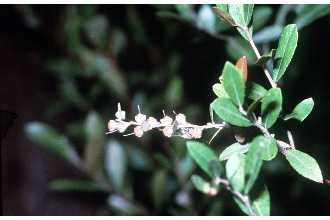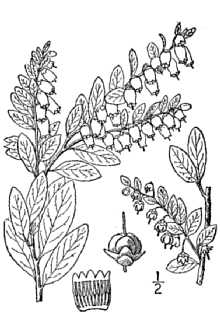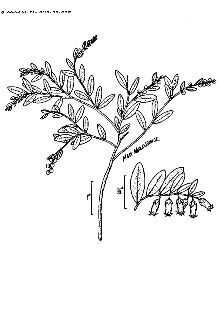Chamaedaphne calyculata (L.) Moench var. nana (Lodd.) E. Busch
Scientific Name: Chamaedaphne calyculata (L.) Moench var. nana (Lodd.) E. Busch

| General Information | |
|---|---|
| Usda Symbol | CHCAN |
| Group | Dicot |
| Life Cycle | Perennial |
| Growth Habits | Shrub |
| Native Locations | CHCAN |
Plant Guide
Uses
Leatherleaf reclaimed large areas in raised bogs in the eastern United States that had been denuded by commercial peat removal, The species is used for nesting and cover by wildlife, including mallards and ruffed grouse, It is a part of browse for sharp-tailed grouse, white-tailed deer, caribou, and moose, , Use soil moisture sensors to measure the soil moisture of Chamaedaphne calyculata (L.) Moench var. nana (Lodd.) E. Busch.
Status
Please consult the PLANTS Web site and your State Department of Natural Resources for this plant’s current status, such as, state noxious status and wetland indicator values.
Description
General: Heath family (Ericaceae). Native perennial, evergreen shrubs 0.3-1.5 meters tall, the stems covered with tiny brownish scales. Leaves are alternate, oblong to elliptic, 1.5-5 cm long, finely toothed, the lower surface covered with tiny brownish scales, becoming smaller and positioned to the upper side of the stem towards the branch tips. The flowers are white, urn-shaped, 6-7 mm long, hanging and arising from one side of the terminal inflorescence, solitary in the axils of the small leaves. Fruits are depressed-globose, woody, gray-brown capsules, persisting through the winter. Common name is in reference to the tough, evergreen leaf. Robert H. Mohlenbrock USDA, NRCS, Wetland Science Institute @ PLANTS Variation within the species: several varieties have been recognized within leatherleaf in North America, based primarily on differences in leaf size and shape (see Fernald 1950). These taxa are currently regarded as within the limits of continuous variation of the species and are not formally recognized. Distribution: Circumboreal; northern North America from Alaska and Yukon and all of Canada (except Franklin) to the easternmost provinces, in the US in the Great Lake states and the Northeast, disjunct and rare in Maryland, North Carolina, and South Carolina.
Adaptation
Leatherleaf occurs in practically all boreal bogs as well as in swamps, lake and stream margins, sedge fens and meadows, black spruce muskegs, and vernal ponds and shrub swamps in pine barrens, usually growing on wet, strongly acidic sphagnum mats over water. It may form thickets as a dominant species in shrub associations in some bogs. It is found at elevations up to 1600 meters. Flowering: April-June from buds formed the previous season; fruiting: June-January.
Establishment
Leatherleaf reproduces by seed and vegetatively by rhizomes. Seed set is usually high (50-95%) when the flowers are open-pollinated but low (1-15%) when flowers are self-fertilized. After cold stratification to break dormancy, the seeds germinate on sphagnum or sedge mats. Moist sphagnum surrounding leatherleaf shoots, roots, and rhizomes causes vigorous vegetative growth. Leatherleaf is the first shrub to enter a bog after sphagnum is established and it is a primary species in extending the bog mat. It remains characteristic of the mature and late stages of moss/low ericaceous shrub communities as open water disappears and may remain dominant for 50 years in some communities. Leatherleaf is shade intolerant and begins to thin as tall shrubs or bog forest species such as tamarack (Larix laricina) and/or black spruce (Picea mariana) establish. Persistence of leatherleaf in bogs over long periods has been attributed to its regeneration following recurrent fire, which is a primary factor in maintaining early successional stages in these communities. Leatherleaf may show a strong increase in stem density following spring burning and may be only slightly injured by summer or autumn fires. Leatherleaf probably survives severe fires because rhizomes are deep in water-saturated substrates and its root crowns and stems are matted in debris. Division is the most successful method of propagation for leatherleaf. Plants may be divided in early fall, planting each rooted clump as a new shrub. Transplanting in summer or autumn stimulated shoot production more than spring transplanting. The ends of shoots also may be bent down to the soil and layered. Young plants should be partially shaded.
Management
Leatherleaf greatly increases following clearcutting. Although leatherleaf and other shrubs can suppress black spruce on medium to poor sites, restocking and regeneration of trees may not affected by shrub density after harvest on other sites. Stocking rates were about the same on burned and unburned cut-over black spruce sites in northern Minnesota. When used for rehabilitation or revegetation, natural growth of leatherleaf can be aided by transplants of sphagnum mats containing live plants. Cultivars, Improved and Selected Materials (and area of origin) Contact your local Natural Resources
Conservation
Service (formerly Soil Conservation Service) office for more information. Look in the phone book under ”United States Government.” The Natural Resources Conservation Service will be listed under the subheading “Department of Agriculture.”
References
Fernald, M.L. 1945. Chamaedaphne calyculata (L.) Moench, var. latifolia (Ait.) comb. nov. Rhodora 47:390-391. Fernald, M.L. 1950. Gray’s manual of botany. Ed. 8. American Book Co., New York, New York. Luteyn, J.L. 1996. Ericaceae of the southeastern United States. Castanea 61:101-144. Pavek, D.S. 1993. Chamaedaphne calyculata. IN: W.C. Fischer (compiler). The fire effects information system [Data base]. USDA, Forest Service, Intermountain Research Station, Intermountain Fire Sciences Laboratory, Missoula, Montana. <http://www.fs.fed.us/database/feis/> Reader, R.J. 1977. Bog ericad flowers: self-compatibility and relative attractiveness to bees. Canadian J. Bot. 55:2279-2287.
Plant Traits
Growth Requirements
| Temperature, Minimum (°F) | -28 |
|---|---|
| Adapted to Coarse Textured Soils | Yes |
| Adapted to Fine Textured Soils | Yes |
| Adapted to Medium Textured Soils | Yes |
| Anaerobic Tolerance | Low |
| CaCO3 Tolerance | Low |
| Cold Stratification Required | No |
| Drought Tolerance | Low |
| Fertility Requirement | Low |
| Fire Tolerance | Medium |
| Frost Free Days, Minimum | 110 |
| Hedge Tolerance | None |
| Moisture Use | High |
| pH, Maximum | 6.0 |
| pH, Minimum | 5.0 |
| Planting Density per Acre, Maxim | 400 |
| Planting Density per Acre, Minim | 100 |
| Precipitation, Maximum | 70 |
| Precipitation, Minimum | 35 |
| Root Depth, Minimum (inches) | 8 |
| Salinity Tolerance | Low |
| Shade Tolerance | Intermediate |
Morphology/Physiology
| Bloat | None |
|---|---|
| Toxicity | None |
| Resprout Ability | Yes |
| Shape and Orientation | Irregular |
| Active Growth Period | Spring and Summer |
| C:N Ratio | Medium |
| Coppice Potential | No |
| Fall Conspicuous | No |
| Fire Resistant | Yes |
| Flower Color | White |
| Flower Conspicuous | No |
| Foliage Color | Yellow-Green |
| Foliage Porosity Summer | Porous |
| Foliage Porosity Winter | Porous |
| Foliage Texture | Fine |
| Fruit/Seed Conspicuous | No |
| Nitrogen Fixation | None |
| Low Growing Grass | No |
| Lifespan | Moderate |
| Leaf Retention | Yes |
| Known Allelopath | No |
| Height, Mature (feet) | 4.0 |
| Height at 20 Years, Maximum (fee | 4 |
| Growth Rate | Moderate |
| Growth Form | Rhizomatous |
| Fruit/Seed Color | Brown |
Reproduction
| Small Grain | No |
|---|---|
| Seedling Vigor | Medium |
| Seed Spread Rate | Slow |
| Fruit/Seed Period Begin | Summer |
| Seed per Pound | 96000 |
| Propagated by Tubers | No |
| Propagated by Sprigs | No |
| Propagated by Sod | No |
| Propagated by Seed | Yes |
| Propagated by Cuttings | Yes |
| Propagated by Container | Yes |
| Propagated by Bulb | No |
| Propagated by Bare Root | Yes |
| Fruit/Seed Persistence | No |
| Fruit/Seed Period End | Fall |
| Fruit/Seed Abundance | Low |
| Commercial Availability | Routinely Available |
| Bloom Period | Early Spring |
| Propagated by Corm | No |
Suitability/Use
| Veneer Product | No |
|---|---|
| Pulpwood Product | No |
| Post Product | No |
| Palatable Human | No |
| Palatable Graze Animal | Low |
| Palatable Browse Animal | Medium |
| Nursery Stock Product | No |
| Naval Store Product | No |
| Lumber Product | No |
| Fodder Product | No |
| Christmas Tree Product | No |
| Berry/Nut/Seed Product | No |


